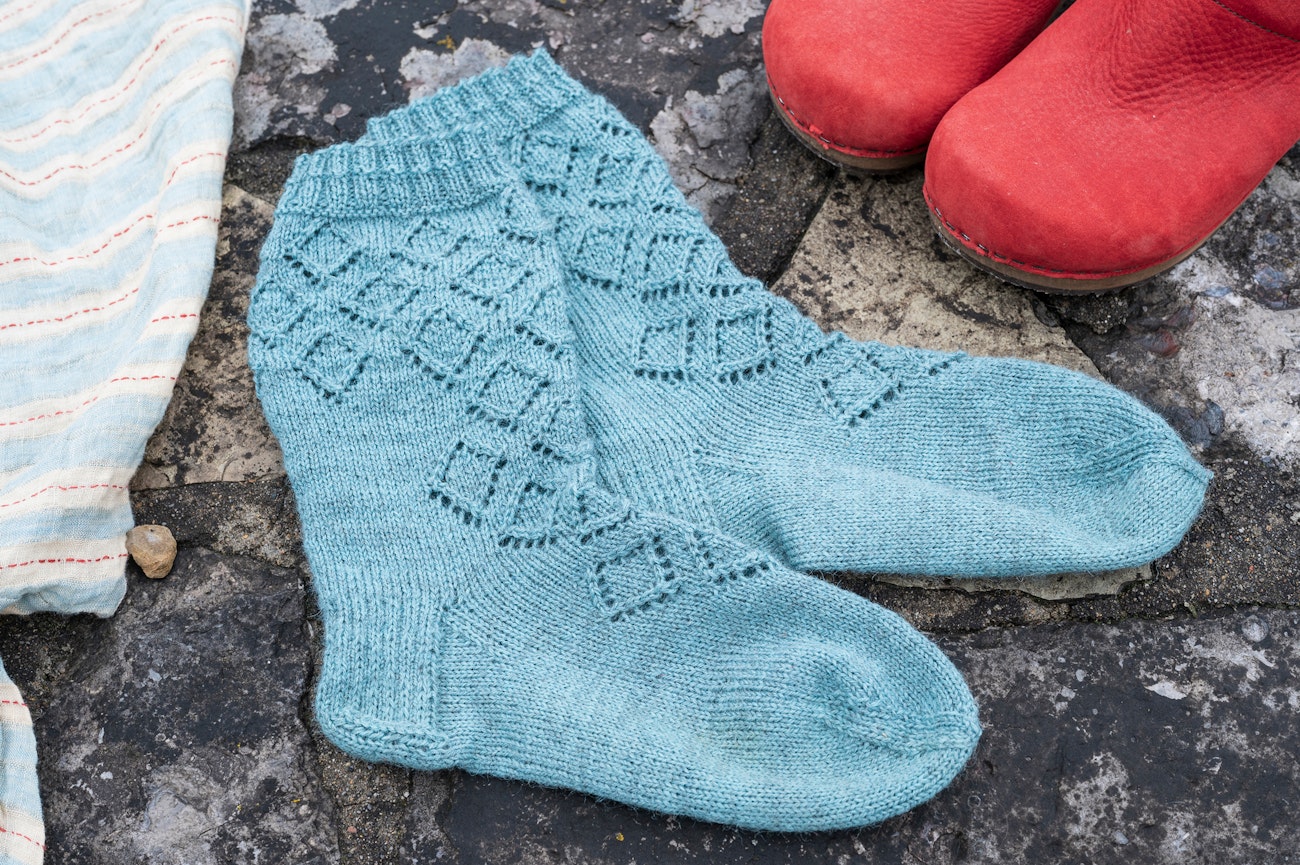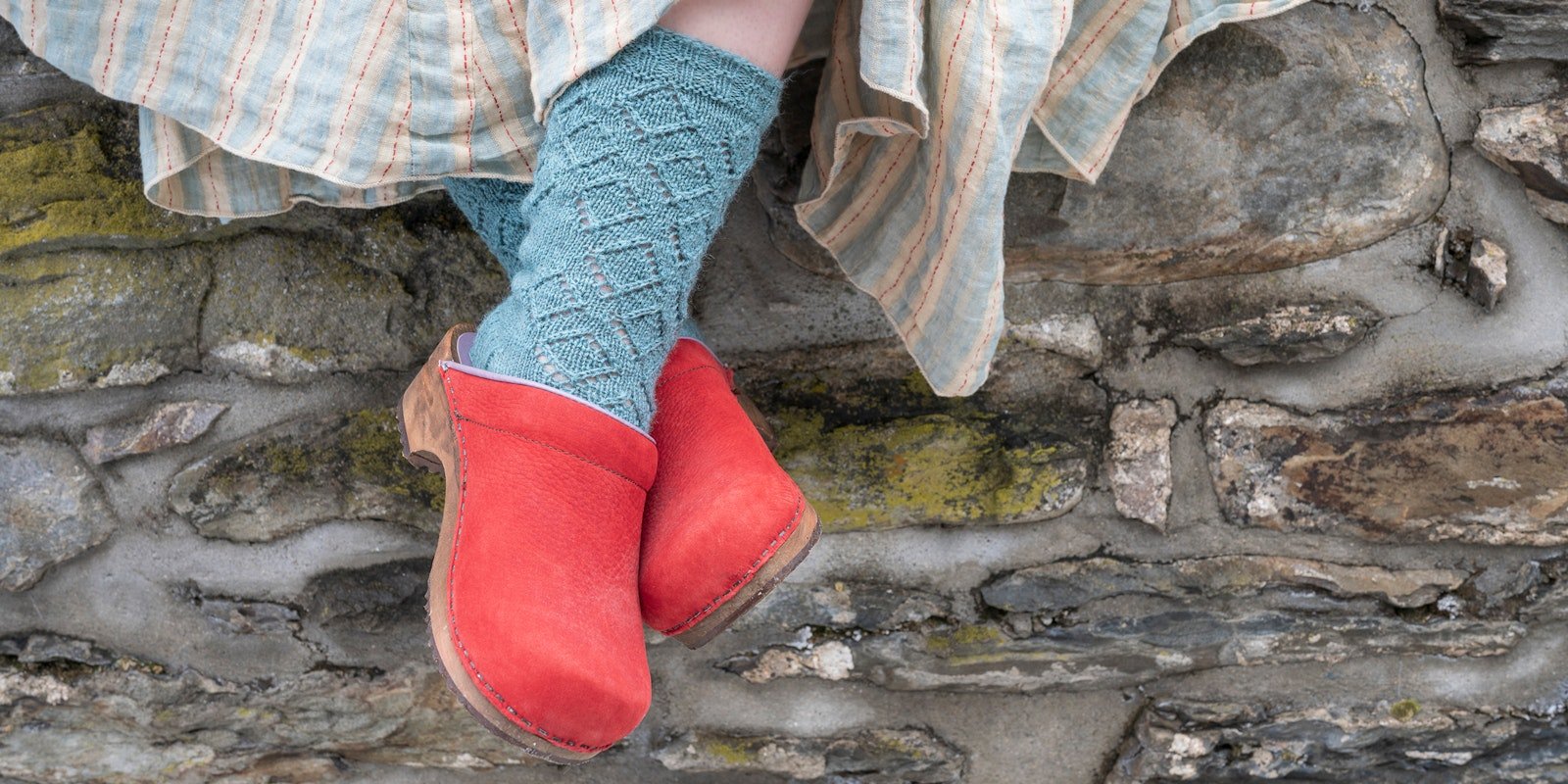Nancy Bush’s love of Estonian culture, lace, and socks are all combined in this pair of socks, which was inspired by a historic pair of women’s stockings. Originally designed with a single size, the pattern has been updated with expanded sizing. The socks shown here are knitted in Rambler, a non-superwash sock yarn created for the yarn shop The Woolly Thistle. The 3-ply yarn comprises the durable wools Dorset and Romney as well as medium-soft Corriedale. (Dorset is said to be naturally shrink-resistant, but wash at your own risk.)
In her original 2008 article, Nancy wrote:
Knitting is a strong part of the folk culture of Estonia. Many parts of the traditional folk costumes were knitted, including gloves, mittens, jackets, caps, socks, and stockings.
Leggings were not totally replaced by stockings until modern times, and the women of Muhu Island wore stockings and leggings together into this century. The stockings that replaced leggings often carried a design that echoed the leggings. The shorter socks (called kapukas or “half-stockings”) and longer stockings from Kihnu have pattern starting just where the leggings would have begun. Kapukas are wide at the top and reach mid-calf. The patterning is inspired by belt designs. These half socks also have clocks on both sides.
Many Estonian stockings have wide belt designs on the legs, and some are decorated with patterns from the ankle to the top of the stocking. Some of the patterns found in these stockings echo those found in mittens: paws, crosses, and the ever-present eight-pointed star. These ornate stockings were mostly women’s wear, while men wore single-colored stockings in black, white, gray, or blue. The men of the Setu region near the border with Russia wore colorful stockings with a broad band of patterning on the legs. Often the feet of stockings or socks were left unpatterned, as the use of precious yarn and time to make a design that would be hidden did not fit into a knitter’s life.

Women’s stockings from the southern part of Estonia, an area called Setumaa, or land of the Setus, inspired my decorative Setu Socks to Knit. The original sock, dating from the nineteenth century, depicted in Kalju Konsin’s book Koekirjalised Kindad ja Sukad (Tartu, Estonia: Eesti NSV Riiklik Etnograafiamuuseum, 1969), is a long stocking with openwork diamond patterns on the leg only. I chose to place the diamond patterns around the upper part of the sock and then run them down the front of the leg and onto the foot.
MATERIALS
Finished Size Foot circumference 8 (8¾, 9½)" (20.5 [22, 24] cm); leg length 8¼ (9½, 9½)" (21 [24, 24] cm) from top of leg to start of heel flap; foot length 9 (9¾, 10¼)" (23 [25, 26] cm) from back of heel to tip of toe (adjustable); to fit women’s U.S. shoe sizes 6½–7½ (8–9, 9½–10½).
Yarn The Woolly Thistle Rambler (80% white Dorset wool, 10% white Corriedale wool, 10% grey Romney wool; 420 yd [384 m]/1¾ oz [50 g]; fingering), Winter Sky, 1 (2, 2) skeins.
Needles Size 1 (2.5 mm), set of 5 double pointed (dpn). Adjust needle size if necessary to obtain gauge.
Notions Stitch holders or scrap yarn (optional); tapestry needle.
Gauge 16 sts and 24 rnds = 2" (5.1 cm) in stockinette stitch and chart patterns worked in the round, before blocking.
Find this pattern in the Farm & Fiber Knits Library: Setu Socks to Knit
Nancy Bush is the author of books including Folk Socks, Knitting Vintage Socks, and Folk Knitting in Estonia. She lives in Salt Lake City, Utah, where she operated the Wooly West mail order source for knitters.

